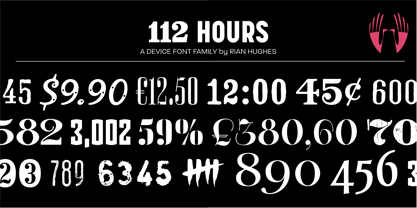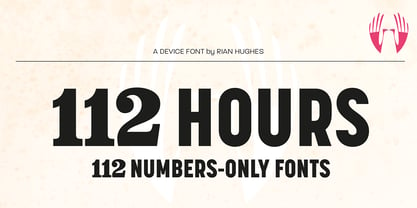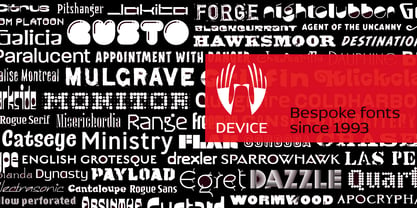Seleccione este tipo de licencia cuando esté desarrollando una aplicación app para iOS, Android o Windows Phone, y vaya a incrustar el archivo en el código de su aplicación móvil. va a incrustar el archivo fuente en el código de su aplicación móvil.
112 Hours
por Device


- Aa Glifos
-
¡Mejor PrecioPaquetes de familia
- Estilos individuales
- Especificaciones técnicas
- Licencias
Sobre la familia 112 Hours Fuente
Rian Hughes’ 15th collection of fonts, “112 Hours”, is entirely dedicated to numbers. Culled from a myriad of sources – clock faces, tickets, watches house numbers – it is an eclectic and wide-ranging set. Each font contains only numerals and related punctuation – no letters. A new book has been designed by Hughes to show the collection, and includes sample settings, complete character sets, source material and an introduction. This is available print-to-order on Blurb in paperback and hardback: http://www.blurb.com/b/5539073-112-hours-hardback http://www.blurb.com/b/5539045-112-hours-paperback From the introduction: The idea for this, the fifteenth Device Fonts collection, began when I came across an online auction site dedicated to antique clocks. I was mesmerized by the inventive and bizarre numerals on their faces. Shorn of the need to extend the internal logic of a typeface through the entire alphabet, the designers of these treasures were free to explore interesting forms and shapes that would otherwise be denied them. Given this horological starting point, I decided to produce 12 fonts, each featuring just the numbers from 1 to 12 and, where appropriate, a small set of supporting characters — in most cases, the international currency symbols, a colon, full stop, hyphen, slash and the number sign. 10, 11 and 12 I opted to place in the capital A, B and C slots. Each font is shown in its entirety here. I soon passed 12, so the next logical finish line was 24. Like a typographic Jack Bauer, I soon passed that too -— the more I researched, the more I came across interesting and unique examples that insisted on digitization, or that inspired me to explore some new design direction. The sources broadened to include tickets, numbering machines, ecclesiastical brass plates and more. Though not derived from clock faces, I opted to keep the 1-12 conceit for consistency, which allowed me to design what are effectively numerical ligatures. I finally concluded one hundred fonts over my original estimate at 112. Even though it’s not strictly divisible by 12, the number has a certain symmetry, I reasoned, and was as good a place as any to round off the project. An overview reveals a broad range that nonetheless fall into several loose categories. There are fairly faithful revivals, only diverging from their source material to even out inconsistencies and regularize weighting or shape to make them more functional in a modern context; designs taken directly from the source material, preserving all the inky grit and character of the original; designs that are loosely based on a couple of numbers from the source material but diverge dramatically for reasons of improved aesthetics or mere whim; and entirely new designs with no historical precedent. As projects like this evolve (and, to be frank, get out of hand), they can take you in directions and to places you didn’t envisage when you first set out. Along the way, I corresponded with experts in railway livery, and now know about the history of cab side and smokebox plates; I travelled to the Musée de l’imprimerie in Nantes, France, to examine their numbering machines; I photographed house numbers in Paris, Florence, Venice, Amsterdam and here in the UK; I delved into my collection of tickets, passes and printed ephemera; I visited the Science Museum in London, the Royal Signals Museum in Dorset, and the Museum of London to source early adding machines, war-time telegraphs and post-war ration books. I photographed watches at Worthing Museum, weighing scales large enough to stand on in a Brick Lane pub, and digital station clocks at Baker Street tube station. I went to the London Under-ground archive at Acton Depot, where you can see all manner of vintage enamel signs and woodblock type; I photographed grocer’s stalls in East End street markets; I dug out old clocks I recalled from childhood at my parents’ place, examined old manual typewriters and cash tills, and crouched down with a torch to look at my electricity meter. I found out that Jane Fonda kicked a policeman, and unusually for someone with a lifelong aversion to sport, picked up some horse-racing jargon. I share some of that research here. In many cases I have not been slavish about staying close to the source material if I didn’t think it warranted it, so a close comparison will reveal differences. These changes could be made for aesthetic reasons, functional reasons (the originals didn’t need to be set in any combination, for example), or just reasons of personal taste. Where reference for the additional characters were not available — which was always the case with fonts derived from clock faces — I have endeavored to design them in a sympathetic style. I may even extend some of these to the full alphabet in the future. If I do, these number-only fonts could be considered as experimental design exercises: forays into form to probe interesting new graphic possibilities.
Diseñadores: Rian Hughes
Editorial: Device
Fundición: Device
Propietario del diseño: Device
MyFonts debut: Apr 23, 2015
Acerca de Device
Device Fuentes es la rama fuente del estudio Device de Rian Hughes, que opera desde Kew Gardens, Londres. Device Fuentes , uno de los primeros colaboradores de la gama FontFont de FontShop, se creó en 1997 para gestionar la creciente biblioteca de Hughes. Ha publicado más de 200 tipos de letra originales que abarcan más de 1.000 pesos individuales, incluidos diseños personalizados para clientes tan diversos como Mac User, 2000AD y The Teenage Mutant Ninja Turtles. Rian estudió en el London College of Communication de Londres antes de trabajar para una agencia de publicidad, Smash Hits, la revista i-D y una serie de empresas de diseño de carátulas de discos. Bajo el estandarte del estudio Device, ofrece diseño, tipografía personalizada e ilustración para campañas publicitarias, fundas de discos, cubiertas de libros, novelas gráficas y televisión. Ha diseñado carteles para la cadena Yellow Boots de la empresa de moda Jun Co. de Tokio, la película animada de seguridad a bordo para Virgin Airlines, la campaña de carteles de Eurostar, una colección de camisas hawaianas, una gama de relojes para Swatch, el folleto de los premios de música de MTV Europa y numerosas ilustraciones de cubiertas de libros y portadas de CD. Ha diseñado numerosos logotipos para DC, Marvel, Valiant, Image y otras empresas de cómics para títulos como Batman, los X-Men, James Bond, Los Vengadores y Spiderman. Vinculado desde hace tiempo al mundo del cómic, la primera novela gráfica de Rian Hughes fue "The Science Service" para la editorial belga Magic Strip. Le siguió "Dare" para la efímera Revolver, de IPC, una "iconoclasta renovación del héroe de cómic de los años 50 Dan Dare", escrita por Grant Morrison. Sus tiras del Galaxy's Greatest se han recopilado en 'Yesterday's Tomorrows' ('Dare', 'Really and Truly' y otras) y 'Tales from Beyond Science' (escritas por Mark Millar, John Smith y Alan McKenzie). Más recientemente, ha escrito y dibujado un relato de "Batman: Black and White", ha colaborado en "Vertigo: Magenta", ha diseñado el mapa del Multiverso DC y se ha reunido con Morrison para escribir dos historias para la revista "Heavy Metal". Ha participado en numerosas exposiciones internacionales, ha dado numerosas conferencias en el Reino Unido y en otros países, y en 2003 expuso su obra en solitario en la Conningsby Gallery de Londres. En 2002 se publicó una monografía retrospectiva, "Art, Commercial", y en 2005 se publicó "Ten Year Itch", una celebración de los diez primeros años de Device Fuentes. Entre sus libros más recientes figuran "Custom Lettering of the 20s and 30s", y la novela gráfica sin palabras para todas las edades "I Am A Number", "Soho Dives, Soho Divas" recoge sus dibujos burlescos, y expone su manifiesto memético en Cult-Ure: Las ideas pueden ser peligrosas. Una colección de sus diseños de logotipos, "Logo a Gogo", fue lanzada en 2018 por Korero Press Tiene una colección de recuerdos de los Thunderbirds, una nevera llena de vodka y una pila de álbumes de música fácil de escuchar que reproduce en voz muy baja. www.rianhughes.com www.devicefonts.co.ukThe La página de fundición Premium se puede ver Aquí.
Seguir leyendo
Leer menos